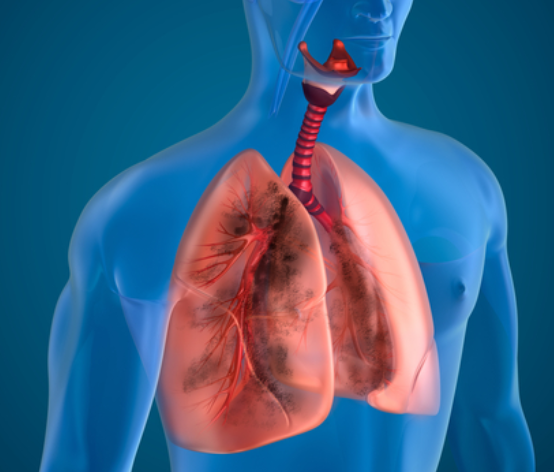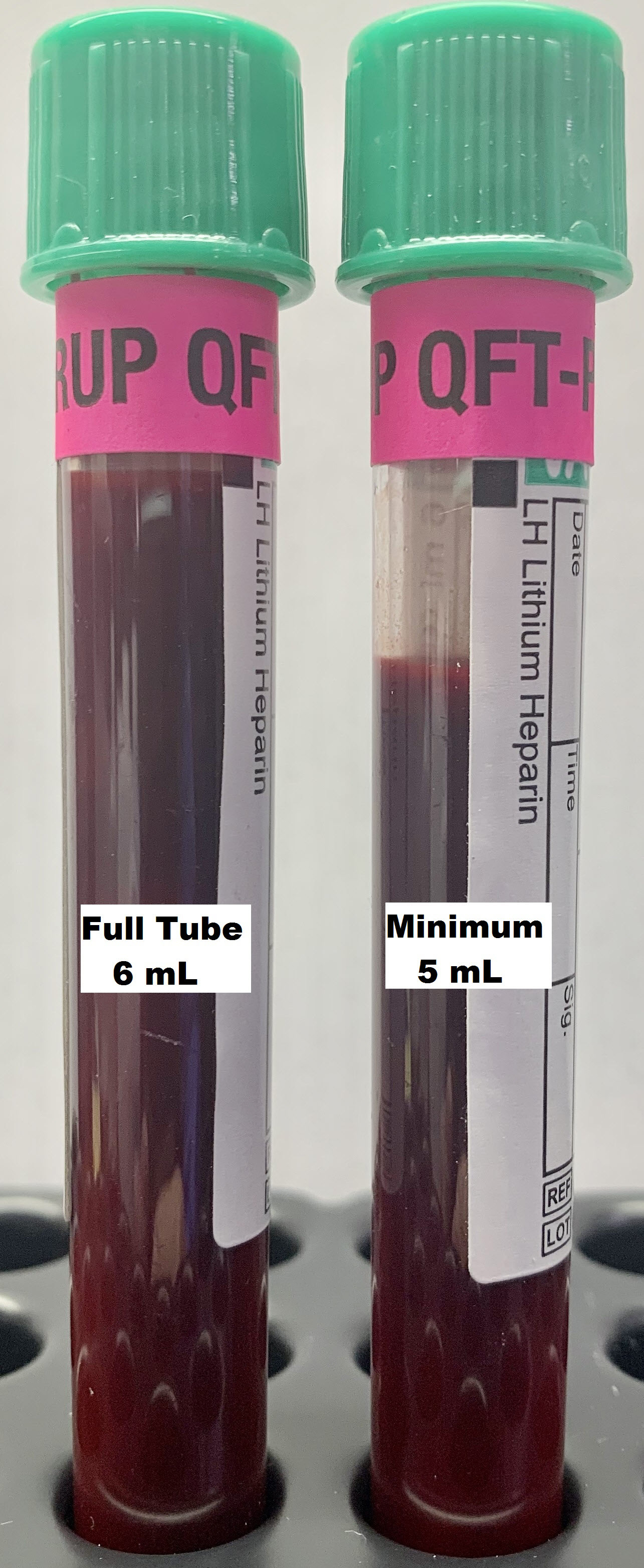ARUP is the only reference laboratory that offers QuantiFERON®-TB Gold Plus with two blood collection options:
QuantiFERON®-TB Gold Plus, 1-Tube (ARUP test code 3000400) (QFT-PLUS)

- Collect 6 mL (5 mL min) of whole blood drawn into an ARUP provided single lithium-heparin tube (ARUP supply # 54015). See Collection tab for more information.
QuantiFERON®-TB Gold Plus, 4-Tube (ARUP test code 3000399) (QFT-4)
- Collect 4 mLs of whole blood – 1 mL in each of the four QFT-Plus blood collection tubes (ARUP Standard supply # 54012 or High Altitude supply #54010). See Collection tab for more information.
Client supplies are currently available: lithium-heparin tubes or 4-tube collection pack on eSupply or call ARUP Client Services at 800-522-2787.
The single lithium-heparin collection tube option (3000400) offers the most convenience to clients. A single lithium-heparin specimen is collected, incubated at room temperature for a minimum of 15 minutes and then shipped refrigerated to ARUP Laboratories, where all further pre-analytic specimen processing is conducted. The single lithium-heparin specimen should be sent to ARUP the same day it is collected in order to avoid exceeding the 48 hour stability. We encourage clients to order QuantiFERON®-TB Gold Plus electronically through their LIS or ARUPConnect. View the interface map here.
If the client cannot send specimens the same day they are collected, then ARUP recommends the QuantiFERON®-TB Gold Plus, 4-Tube assay (3000399). The 4-tube assays requires the same pre-analytical processing steps as the current 3-tube QuantiFERON®-TB Gold assay.
The new QuantiFERON®-TB Gold Plus assays use the same principles, test procedures as the current assay, but is optimized with tuberculosis-specific antigens that elicit both CD8+ and CD4+ T cell responses—enabling a more comprehensive assessment of cell-mediated immune response to TB infection.
For more questions, contact ARUP Client Services at 800-522-2787, keyword: quantiferon.
QuantiFERON®-TB Gold Plus
Special collection and preparation instructions
3000400, QuantiFERON®-TB Gold Plus, 1-Tube collection instructions

Collect 6 mL (5 mL min) whole blood directly into the QuantiFERON®-TB LiHep Collection Tube (ARUP supply #54015) available online through eSupply using ARUP Connect™ or contact ARUP Client Services at 800-522-2787.
- Note: The specimen must be submitted in the ARUP-provided collection tube due to the requirements of the laboratory automation. No other lithium heparin tubes are acceptable.
- Do not draw specimens on the day of or the day prior to a federal holiday.
- Please note that tubes with less than 5 mL of blood will not be accepted.
- After collection, thoroughly mix the specimen by slowly inverting the tube a minimum of 10 times. Inversion should be performed slowly enough to ensure the airspace reaches the opposite end of the tube each time.
- Allow the specimen to remain at room temperature for a minimum of 15 minutes.
- After 15 minutes at room temperature, refrigerate the specimen within three hours of collection and transport to ARUP.
- Send the specimen to ARUP the same day it is collected.
Stability:
Ambient: 3 hours; Refrigerated: 48 hours; Frozen: Unacceptable
Storage/Transport Temperature:
Refrigerated
3000399, QuantiFERON®-TB Gold Plus, 4-Tube collection instructions
At altitudes from sea level to 2,650 feet
- Collect 1 mL (Min: 0.8 mL, Max 1.2 mL) of whole blood directly into each of the four tubes in the QuantiFERON®-TB (Standard) 4 In-Tube Collection Kit (ARUP supply #54012) available online through eSupply using ARUP Connect™ or contact ARUP Client Services at 800-522-2787.
- Note: Tubes should be between 17°C and 25°C (63°F to 77°F) at the time of blood collection.
- Immediately after filling the tubes, shake them ten (10) times just firmly enough to ensure the entire inner surface of the tube is coated with blood, to solubilize antigens on the tube walls.
- Note: Over-energetic shaking may cause gel disruption and could lead to aberrant results.
- After mixing, and within 16 hours of collection, incubate upright at 37°C for 16 – 24 hours.
- After incubation, centrifuge for 15 minutes at 2000–3000 RCF (g).
- After centrifugation, transport entire contents in each of the 4 original collection tubes.
Stability:
After incubation and centrifugation: Ambient: 2 hours; Refrigerated: 4 weeks; Frozen: Unacceptable
Storage/Transport Temperature:
Refrigerated
At altitudes from 2,650 – 3,350 feet
- When collecting at elevations between 2,650 and 3,350 feet, it is recommended that blood be collected using a syringe. Collect 4 mL of blood into the syringe then immediately transfer 1 mL into each of the four tubes in the QuantiFERON®-TB (Standard) 4 In-Tube Collection Kit (ARUP supply #54012) available online through eSupply using ARUP Connect™ or contact ARUP Client Services at (800) 522-2787.
- Note: Tubes should be between 17°C and 25°C (63°F to 77°F) at the time of blood collection.
- Immediately after filling the tubes, shake them ten (10) times just firmly enough to ensure the entire inner surface of the tube is coated with blood, to solubilize antigens on the tube walls.
- Note: Over-energetic shaking may cause gel disruption and could lead to aberrant results.
- After mixing, and within 16 hours of collection, incubate upright at 37°C for 16 – 24 hours.
- After incubation, centrifuge for 15 minutes at 2000 – 3000 RCF (g).
- After centrifugation, transport entire contents in each of the 4 original collection tubes.
Stability:
After incubation and centrifugation: Ambient: 2 hours; Refrigerated: 4 weeks; Frozen: Unacceptable
Storage/Transport Temperature:
Refrigerated
At altitudes from 3,350 – 6,150 feet
- Collect 1 mL (Min: 0.8 mL, Max 1.2 mL) of whole blood directly into each of the four tubes in the QuantiFERON®-TB (High Altitude) 4 In-Tube Collection Kit (ARUP supply #54010) available online through eSupply using ARUP Connect™ or contact ARUP Client Services at (800) 522-2787.
- Note: Tubes should be between 17°C and 25°C (63°F to 77°F) at the time of blood collection.
- Immediately after filling the tubes, shake them ten (10) times just firmly enough to ensure the entire inner surface of the tube is coated with blood, to solubilize antigens on the tube walls.
- Note: Over-energetic shaking may cause gel disruption and could lead to aberrant results.
- After mixing, and within 16 hours of collection, incubate upright at 37°C for 16 – 24 hours.
- After incubation, centrifuge for 15 minutes at 2000 – 3000 RCF (g).
- After centrifugation, transport entire contents in each of the 4 original collection tubes.
Stability:
After incubation and centrifugation: Ambient: 2 hours; Refrigerated: 4 weeks; Frozen: Unacceptable
Storage/Transport Temperature:
Refrigerated
At altitudes above 6,150 feet
- When collecting at elevations above 6,150 feet, it is recommended that blood be collected using a syringe. Collect 4 mL of blood into the syringe then immediately transfer 1 mL into each of the four tubes in the QuantiFERON®-TB (High Altitude) 4 In-Tube Collection Kit (ARUP supply #54010) available online through eSupply using ARUP Connect™ or contact ARUP Client Services at (800) 522-2787.
- Note: Tubes should be between 17°C and 25°C (63°F to 77°F) at the time of blood collection.
- Immediately after filling the tubes, shake them ten (10) times just firmly enough to ensure the entire inner surface of the tube is coated with blood, to solubilize antigens on the tube walls.
- Note: Over-energetic shaking may cause gel disruption and could lead to aberrant results.
- After mixing, and within 16 hours of collection, incubate upright at 37°C for 16 – 24 hours.
- After incubation, centrifuge for 15 minutes at 2000 – 3000 RCF (g).
- After centrifugation, transport entire contents in each of the 4 original collection tubes.
Stability:
After incubation and centrifugation: Ambient: 2 hours; Refrigerated: 4 weeks; Frozen: Unacceptable
Storage/Transport Temperature:
Refrigerated
Additional Resources
- QuantiFERON®-TB Gold Plus Blood Collection Information Sheet
- QuantiFERON®-TB Gold Plus Training Videos - Blood Collection Training
If help is needed determining whether specimens can be transported to ARUP within 48 hours, please contact the ARUP Transporation Department at TransportationPRS@aruplab.com.
References
- Barcellini L, et al. First independent evaluation of QuantiFERON®-TB Plus performance. Eur Respir J. 2016 May;47(5):1587–90.
- Chicchio T, et al. Polyfunctional T-cells and effector memory phenotype are associated with active TB in HIV-infected patients. J Infect. 2014 Dec;69(6):533–45.
- Ongaya A, et al. Mycobacterium tuberculosis-specific CD8+ T cell recall in convalescing TB subjects with HIV co-infection. Tuberculosis(Edinb). 2013 Dec; 93(Suppl), S60–5.
- Lancioni C, et al. CD8+ T cells provide an immunologic signature of tuberculosis in young children. Am J Respir Crit Care Med. 2012 Jan 15;185(2):206–12.
- End TB Strategy. World Health Organization. http://www.who.int/tb/post2015_strategy/en/. Accessed January 15, 2019.
- Guidelines on the management of latent tuberculosis infection. World Health Organization. http://www.who.int/tb/publications/latent-tuberculosis-infection/en/. 2018. Accessed January 15, 2019.
Publications
- Moon HW, et al. Evaluation of QuantiFERON®-TB Gold-Plus in health care workers in a low-incidence setting. J Clin Microbiol. 2017 Jun;55(6):1650–7.
- Barcellini, L. et al. First independent evaluation of QuantiFERON®-TB Plus performance. Eur Respir J. 2016 May;47(5):1587–90.
- Hoffmann H, et al. Equal sensitivity of the new generation QuantiFERON®-TB Gold Plus in direct comparison with the previous test version QuantiFERON®-TB Gold IT. Clin Microbiol Infect. 2016 Aug;22(8):701–3.
- Petruccioli E, et al. Characterization of the CD4 and CD8 T-cell response in the QuantiFERON®-TB Gold Plus kit. Int J Mycobacteriol. 2016 Dec;5 Suppl 1:S25–6.
Additional Information
Frequently Asked Questions
How do clients obtain the single lithium-heparin tube?
QuantiFERON®-TB LiHep Collection Tube (ARUP supply #54015) available online through eSupply using ARUP Connect™ or contact ARUP Client Services at (800) 522-2787.
Can clients use their own lithium-heparin tube?
No. The lithium-heparin tube supplied by ARUP was validated for our high-volume automation system.
Why doesn’t ARUP offer the T-SPOT® testing?
The T-SPOT® is very difficult to get turned around in the manufacturer indicated stability times. Also the test is manually interpreted, which introduces another concern from a lab perspective in regards to reproducibility. Even with the new “XTend” product that Oxford now sells, it would be nearly impossible for ARUP to get specimens transported, in-house to ARUP, and tested within stability limits set by the FDA approval. If the Quantiferon® tubes are collected according to the explicate instructions on our web-site, and transported appropriately we can meet all FDA guidance. Based on the stability issues with the T-SPOT® testing, as well as the variability of manually counting “spots” the decision was made a while ago not to bring this testing into ARUP.
Is there a clinical difference in results between the T-SPOT® and Quantiferon®-TB Gold?
CDC did a large study and published it in 2012 in which they showed that neither test is sufficiently better than the other. They are both imperfect and require additional follow-up testing in low prevalence populations. In terms of the clinical utility it comes down to convenience and practicality. The Quantiferon® assay is more convenient and practical due to the stability issues surrounding the T-SPOT®. Quantiferon®-TB Gold and the T-SPOT® are considered equivalent clinically. The T-SPOT® has an equivocal range, which is the only real difference in the test interpretation.

















